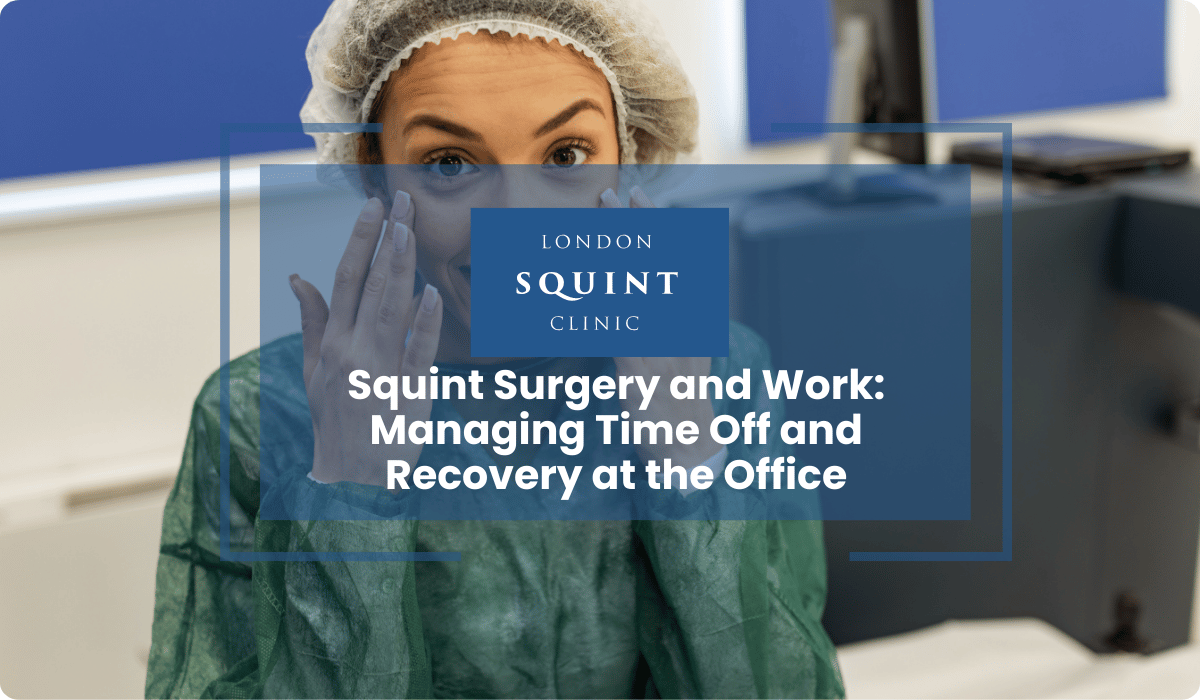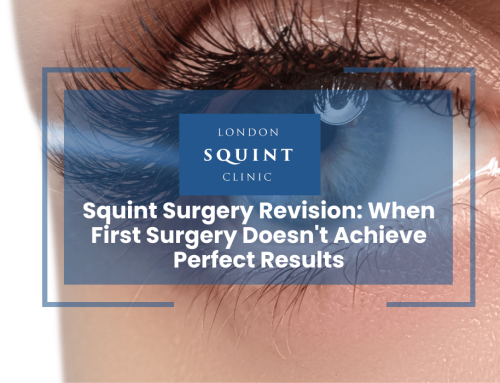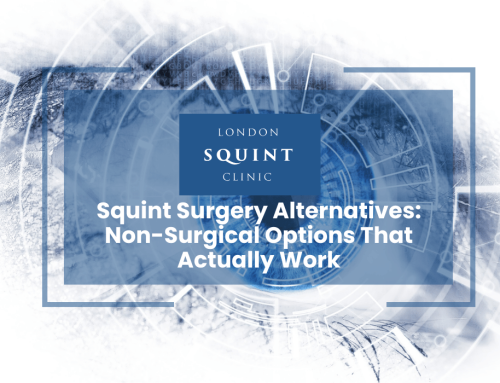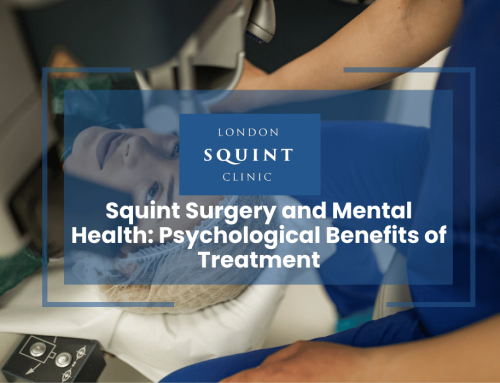Squint Surgery and Work: Managing Time Off and Recovery at the Office
Essential Recovery Guidelines for Returning to Work After Squint Surgery
- Most office workers require 1-2 weeks off work after squint surgery, with physically demanding or visually intensive jobs needing 2-3 weeks
- Implement a gradual return strategy starting with half days and limited screen time, progressing to full schedules over 3-4 weeks
- Use the 20-20-20 rule when working with computers: every 20 minutes, look at something 20 feet away for 20 seconds
- Request temporary workplace adjustments including ergonomic setups, controlled lighting, and flexible scheduling
- Communicate proactively with employers, providing medical documentation and specific accommodation needs
- Prioritize recovery by delegating tasks where possible and setting clear boundaries with colleagues
- Remember that while external healing appears complete within weeks, your visual system continues adapting for several months
Table of Contents
- Understanding Squint Surgery Recovery Timeline
- How Much Time Off Work Do You Need After Squint Surgery?
- Managing Computer Work Following Eye Alignment Surgery
- Workplace Adjustments to Support Your Recovery Process
- Returning to Office Work: Gradual Transition Strategies
- Communicating with Employers About Squint Surgery Leave
- Balancing Professional Responsibilities During Recovery
Understanding Squint Surgery Recovery Timeline
Squint surgery (strabismus surgery) is a procedure designed to realign the eyes by adjusting the eye muscles. While highly effective, it requires a structured recovery period that patients need to understand, particularly when planning their return to work.
The typical recovery timeline following squint surgery progresses through several distinct phases:
- Immediate post-operative period (1-3 days): Expect moderate discomfort, redness, and watering. Vision may be blurry, and light sensitivity is common.
- Early recovery (4-7 days): Discomfort begins to subside, though redness remains. Vision starts improving but may still be unstable.
- Intermediate recovery (1-2 weeks): Most surface redness diminishes, and vision stabilises further. Eye fatigue remains a concern, especially with prolonged visual tasks.
- Extended recovery (3-6 weeks): Complete healing of eye muscles and adaptation to the new eye alignment. Visual system continues to adjust.
It’s important to note that while the external healing appears complete within a couple of weeks, the internal adaptation of your visual system continues for several weeks. This extended neurological adjustment period affects your ability to perform visually demanding tasks, including office work and computer use.
How Much Time Off Work Do You Need After Squint Surgery?
The amount of sick leave required after squint surgery varies depending on several factors, including the complexity of your procedure, your specific occupation, and your individual healing response. However, we can provide general guidelines to help you plan appropriately.
For most patients, we recommend:
- Desk-based or administrative roles: 1-2 weeks off work, with potential adjustments upon return
- Jobs requiring significant visual concentration: 2 weeks minimum, with a gradual return to full visual tasks
- Physically demanding occupations: 2-3 weeks, particularly if the role involves dust, debris or risk of eye contact
- Driving-intensive positions: 2-4 weeks, as depth perception and peripheral vision may take longer to fully stabilise
These timeframes represent average recovery periods. Your specific squint surgery recovery may vary based on individual factors. During your pre-operative consultation, we’ll discuss your occupation in detail and provide personalised guidance on expected time off work.
Remember that returning too early can prolong your overall recovery and potentially compromise your surgical outcome. It’s better to take adequate time initially than to rush back and experience complications that might necessitate additional time off later.
Managing Computer Work Following Eye Alignment Surgery
Computer work presents particular challenges after squint surgery due to the visual concentration required and the potential for eye strain. Most patients can resume limited computer use after 7-10 days, but should implement specific strategies to protect their recovery.
When returning to computer work, follow these evidence-based recommendations:
- Implement the 20-20-20 rule: Every 20 minutes, look at something 20 feet away for at least 20 seconds to reduce eye strain
- Adjust screen settings: Reduce brightness to a comfortable level and consider using night mode or blue light filters
- Increase text size: Temporarily enlarge fonts to reduce visual effort during the adaptation period
- Position your monitor correctly: Place it slightly below eye level and approximately arm’s length away
- Use artificial tears: Apply preservative-free lubricating drops as recommended by your surgeon to combat dryness from reduced blinking
During the first week back, limit continuous computer work to 30-minute intervals with 10-minute breaks. Gradually increase duration as comfort allows. If you experience increased redness, pain, or visual disturbances during computer use, take a longer break and consult your surgeon if symptoms persist.
Remember that your visual system is still adapting to its new alignment, and digital screens can be particularly challenging during this period. Patience with this process will support optimal long-term results.
Workplace Adjustments to Support Your Recovery Process
Appropriate workplace adjustments can significantly enhance your recovery experience and facilitate a successful return to work after squint surgery. These modifications are typically temporary but essential for protecting your surgical outcome and visual comfort.
Consider requesting the following workplace adjustments:
- Ergonomic workstation setup: Ensure proper monitor height, keyboard position, and seating to minimise neck strain that can affect eye comfort
- Controlled lighting: Reduce glare from windows and overhead lighting; consider requesting an anti-glare screen filter
- Reduced visual tasks: Temporarily reassign visually demanding responsibilities where possible
- Flexible scheduling: Request staggered hours to avoid peak commuting times or to work when your eyes feel freshest
- Private space: If available, a quieter workspace can reduce visual distractions that may strain your eyes
In the UK, employers have a legal obligation to make reasonable adjustments for employees recovering from medical procedures. The Equality Act 2010 provides protection for temporary medical conditions that affect your ability to perform normal activities. Your occupational health department can help formalise these adjustments and ensure they’re implemented appropriately.
Document all agreed adjustments in writing, including their expected duration and review dates. This creates clarity for both you and your employer during the recovery process.
Returning to Office Work: Gradual Transition Strategies
A phased return to work often provides the most successful transition after squint surgery. This approach allows your visual system to gradually readapt to workplace demands while continuing to heal from the procedure.
An effective phased return protocol might include:
- Week 1: Return for half days (3-4 hours) with frequent breaks and limited screen time
- Week 2: Increase to 5-6 hour days with structured break periods and modified duties
- Week 3: Return to full days but maintain regular visual breaks and continue any necessary workstation adjustments
- Week 4: Resume normal working patterns while maintaining good visual hygiene practices
During this transition period, be particularly mindful of visual fatigue signals such as increased eye discomfort, headaches, or temporary blurring of vision. These symptoms indicate you may need to slow your progression or implement additional accommodations.
Consider scheduling follow-up appointments with your surgeon at strategic points during your return-to-work process. This allows for professional assessment of your recovery and timely adjustments to your workplace reintegration plan if needed.
Remember that a successful gradual return not only protects your surgical outcome but also demonstrates to your employer your commitment to resuming full productivity in a responsible manner.
Communicating with Employers About Squint Surgery Leave
Clear, proactive communication with your employer about your squint surgery and recovery needs is essential for a smooth workplace experience. Approaching these conversations professionally and with appropriate medical documentation will help ensure you receive the support and accommodations necessary.
Follow these guidelines when discussing your surgery with employers:
- Provide advance notice: Inform your employer as soon as your surgery date is confirmed, ideally giving at least 3-4 weeks’ notice
- Be specific about timeframes: Clearly communicate the expected duration of your absence based on your surgeon’s recommendations
- Obtain proper documentation: Request a formal medical certificate or fit note from your surgeon detailing your procedure and recommended recovery period
- Discuss gradual return options: Present a proposed phased return plan based on your surgeon’s guidance
- Outline required accommodations: Specify any temporary workplace adjustments that will support your successful return
When discussing your condition, you need only share details relevant to your work capabilities and accommodation needs. Focus on specific functional limitations rather than detailed medical information. For example, explain that you’ll temporarily need reduced screen time rather than describing the technical aspects of your eye muscle surgery.
Remember that most employers appreciate employees who take a responsible approach to their recovery, as this ultimately results in a more successful and sustainable return to full productivity.
Balancing Professional Responsibilities During Recovery
Managing professional obligations while prioritising your recovery requires thoughtful planning and boundary-setting. Finding this balance is crucial for both your surgical outcome and your career wellbeing.
Consider these strategies for effectively balancing work and recovery:
- Delegate where possible: Identify tasks that could temporarily be reassigned to colleagues during your recovery period
- Prioritise essential responsibilities: Focus your limited visual energy on critical tasks and postpone less urgent matters
- Utilise alternative communication methods: Consider phone calls instead of emails or video conferences when appropriate to reduce screen time
- Schedule recovery-friendly work periods: Plan demanding visual tasks during times when your eyes typically feel freshest, often in the morning
- Set clear boundaries: Communicate your temporary limitations to colleagues to manage expectations appropriately
Visual fatigue management becomes particularly important during this period. Learn to recognise early signs of eye strain such as increased discomfort, headaches, or difficulty focusing. When these symptoms appear, take a visual break rather than pushing through, which could prolong your overall recovery.
Remember that squint surgery represents a significant investment in your long-term visual health and quality of life. Protecting your surgical outcome by respecting your recovery needs ultimately serves both your personal and professional interests. Most workplace demands can be temporarily adjusted, but compromising your surgical recovery could have lasting consequences.
With proper planning, communication, and self-advocacy, you can successfully navigate your professional responsibilities while ensuring optimal healing from your squint surgery.
Frequently Asked Questions
How long should I take off work after squint surgery?
Most patients should take 1-2 weeks off work after squint surgery, depending on their job type. Desk-based roles typically require 1-2 weeks, visually demanding jobs need at least 2 weeks, physically demanding occupations require 2-3 weeks, and driving-intensive positions may need 2-4 weeks. Your surgeon will provide personalized guidance based on your specific procedure and occupation.
When can I use a computer after strabismus surgery?
You can typically resume limited computer use 7-10 days after squint surgery. Begin with 30-minute sessions followed by 10-minute breaks, and gradually increase duration as comfort allows. Implement the 20-20-20 rule (every 20 minutes, look at something 20 feet away for 20 seconds), adjust screen settings, increase text size, and use artificial tears to minimize eye strain during your recovery period.
What workplace accommodations should I request after eye alignment surgery?
After squint surgery, beneficial workplace accommodations include: an ergonomic workstation setup, controlled lighting with reduced glare, temporary reassignment of visually demanding tasks, flexible scheduling options, and a quieter workspace if available. UK employers are legally obligated to make reasonable adjustments under the Equality Act 2010 for employees recovering from medical procedures.
How should I plan a phased return to work after strabismus surgery?
An effective phased return after squint surgery typically follows this pattern: Week 1 – half days (3-4 hours) with frequent breaks; Week 2 – increased to 5-6 hour days with structured breaks; Week 3 – full days with regular visual breaks; Week 4 – normal working patterns while maintaining good visual hygiene. Adjust this timeline based on your recovery progress and surgeon’s recommendations.
What should I tell my employer about my squint surgery recovery needs?
When discussing squint surgery with your employer, provide advance notice (3-4 weeks ideally), specify your expected absence duration, present a formal medical certificate, propose a phased return plan, and outline any temporary accommodations needed. Focus on explaining functional limitations relevant to your work rather than detailed medical information, and emphasize your commitment to returning to full productivity.
How can I manage eye strain when returning to computer work after strabismus surgery?
To manage eye strain when returning to computer work after squint surgery: follow the 20-20-20 rule, reduce screen brightness, use blue light filters, increase text size temporarily, position your monitor at arm’s length and slightly below eye level, apply preservative-free lubricating drops as recommended, and take regular breaks. If you experience increased redness, pain, or visual disturbances, take longer breaks and consult your surgeon if symptoms persist.
How long does it take for vision to stabilize after squint surgery?
Vision begins to stabilize within 1-2 weeks after squint surgery (during the intermediate recovery phase), but complete adaptation of your visual system continues for 3-6 weeks. While external healing appears complete within a couple of weeks, the internal neurological adjustment period affects your ability to perform visually demanding tasks for several weeks. Full stabilization varies between individuals and depends on the complexity of your procedure.
Find out if you are suitable for Double Vision Treatment
Not everyone is eligible for double vision surgery.
Find out if you could benefit from this life-changing surgery by taking the quick self-suitability quiz below:
Our most popular procedures

Hello, I’m Nadeem Ali
I’m one of the few eye surgeons in the world with 100% focus on Squint and Double Vision Surgery.
I have 24 years of eye surgery experience, and worked for 13 years as a Consultant at London’s renowned Moorfields Eye Hospital.
In 2023, I left the NHS to focus fully on treating patients from across the world at the London Squint Clinic. You can read more about me here.
There’s lots of information on the website about: squint surgery, double vision surgery and our pricing.
The most rewarding part of my job is hearing patients tell me how squint or double vision surgery has changed their lives. You can hear these stories here.
Mr Nadeem Ali
MA MB BChir MRCOphth FRCSEd(Ophth)





